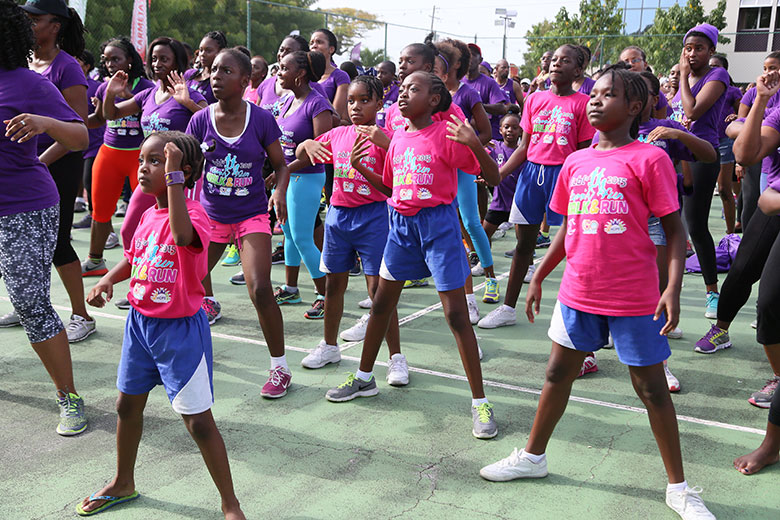
Photo: PAHO
In an age dominated by screens and sedentary lifestyles, the call for physical activity has never been more urgent, especially for our school-age children. The mental, physical and cognitive benefits of physical activity have been unequivocally proven. Yet there remains a glaring deficit in physical activity opportunities within schools, particularly in regions like the Caribbean, including Jamaica, where the burden of non-communicable diseases (NCDs) looms large over public health systems. If implemented as intended, the proposed Jamaica School Nutrition Policy could help to facilitate more physical activity opportunities for generations to come.
For school-age children, regular physical activity is crucial for their growth and development. It not only helps them maintain a healthy weight but also fosters stronger bones and muscles, improves cardiovascular health, and boosts mood and cognitive function. Too much sedentary behaviour – or periods of sitting or lying down with little to no movement- can also increase the risk of obesity and affect sleep duration. Active children are more likely to develop lifelong habits of physical activity, reducing their risk of developing NCDs later in life.
Beyond the benefits, states also have an obligation to provide children with access to the highest attainable standard of health which includes opportunities to be active and to engage in play, as they are signatories to the Convention on the Rights of the Child (CRC). Yet, according to recent statistics, a significant percentage of school-age children in the region do not meet the recommended levels of physical activity as almost two thirds are insufficiently physically active, over 40% are sedentary, and over 20% are physically inactive, more frequent among girls than boys. Factors such as limited access to sports facilities, lack of physical education classes, and sedentary lifestyles exacerbated by excessive screen time contribute to this concerning trend. Thus, it is imperative that they are provided with multiple, diverse opportunities to be active. For instance, skipping, dancing, or cycling are examples of aerobic exercises. Playing on playground equipment is an example of a muscle-building activity; and engaging in sports like basketball or running and hopscotch are examples of bone-strengthening exercises.
Schools continue to be a critical environment for facilitating healthy habits. Children spend more time in school than in any other setting. Thus there is a need for sustained and strategic physical activity interventions within the school setting. The Ministry of Health and Wellness (MOHW) deserves credit for actively promoting the increased level of physical activity through initiatives like Jamaica Moves in School, which started in 2018. One of the three components of the project, which is a collaboration between the Ministry and the Ministry of Education and Youth (MOEY) is to increase physical activity. In addition, a number of initiatives have been carried out under this programme, including the Jamaica School Ambassador programme, which selects teachers and students to support the message of fostering a healthier school environment, and National School Moves Day, which is scheduled for April 26 and encourages schools across the island to participate in one hour of physical activity for the day.
However, there is more that can be done to facilitate a comprehensive approach to physical activity, elements of which are proposed in the National School Nutrition Policy Green Paper. The last available version of the policy includes the need to provide:
- Physical activities for children from early childhood to grade 13
- Three five-minute physical activity breaks per day
- A minimum of one hour of physical activity per week
- Physical education in schools as guided by the curriculum
- A safe, secure, and suitable play area for all students
- Access to safe and age-appropriate physical activity facilities and equipment
Beyond these factors, the World Health Organisation (WHO) encourages member states to adopt a whole-of-school approach to promoting physical activity which includes active classrooms (movement during class), quality physical education, facilitation of physical activity opportunities before and after school, at playtime and active transportation.
The need to urgently prioritize proactive public health interventions, such as the School Nutrition Policies is critical given its wider impact on the public health system. NCDs such as diabetes, hypertension, and obesity are on the rise, placing an immense burden on healthcare resources and diminishing the quality of life for affected individuals. In Jamaica alone, NCDs account for a substantial portion of the country’s healthcare expenditure, diverting funds away from other crucial areas of health promotion and care.
In 2025, the Fourth High-level Meeting on NCDs will be held where heads of governments will assess the progress on 9 voluntary global targets for the prevention and control of NCDs, including physical activity. It is not too late for Jamaica and the wider Caribbean to shine in prioritizing strong comprehensive policy action as recommended by the Caribbean Moves which was recently endorsed by CARICOM, and the 2023 Bridgetown Declaration on NCDs and Mental Health.
To address this pressing issue, action must be taken now, and it starts with prioritizing physical activity within schools. First and foremost, the government must urgently implement the proposed School Nutrition policy and consider collaboration between schools, communities, and healthcare providers to promote and sustain physical activity in and beyond the school setting.
In addition, priority should be given to:
- Building Awareness: Continue with efforts such as Jamaica Moves as a physical activity awareness and promotion mechanism so that all, including teachers and parents should be educated about the benefits of physical activity to support and encourage children in their pursuits. As guided by the WHO and PAHO, the campaign to enhance awareness should also highlight the social, economic, and environmental co-benefits of physical activity. For example, facilitation of active transportation such as walking and cycling can reduce carbon emissions and help to mitigate climate change.
- Active Environments: The government should be commended for its intention to establish parks across the island. Ensure that these are also safe and accessible spaces for children to engage in physical activity outside of school hours.
- Continuous Monitoring and Evaluation: Regular monitoring and evaluation of physical activity programs and policies within schools are essential to assess their effectiveness and make necessary adjustments to ensure long-term success.
Finally, adults, including teachers, parents, and community leaders, should serve as positive role models by prioritizing their own physical activity and demonstrating its importance through their actions.
The time to act is now. By prioritizing physical activity within schools and communities, we can empower our children to lead healthier lives, reduce the burden of NCDs on our public health system, and pave the way for a brighter and more active future.
We join our voices with other advocates in asking: Why delay the implementation of a policy crucial for the current and future health and wellness of the nation’s children?
Offniel Lamont is the Physiotherapist at the G.C. Foster College of Physical Education and Sport. He holds a Masters degree from University College London (UCL) in Sports Medicine, Exercise, and Health whose focus area is leveraging exercise as a powerful tool in the prevention and treatment of sports injuries and NCDs. Lamont’s commitment also extends to empowering Caribbean youth as a dedicated advocate within the Healthy Caribbean Coalition.
Danielle Walwyn is the Advocacy Officer for the Healthy Caribbean Coalition’s Childhood Obesity Prevention and Healthy Food Policy Programme. She holds a Masters degree from Queen’s University (Canada) with a specialization in Health Promotion and a focus on physical activity.
